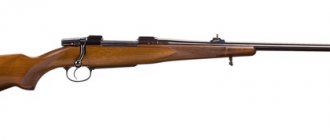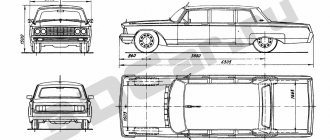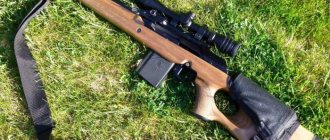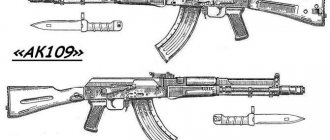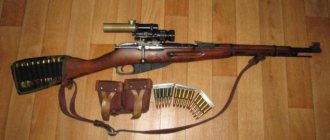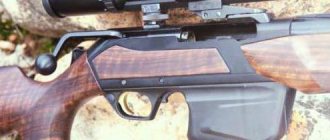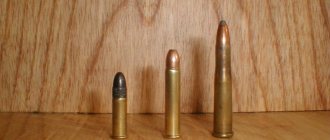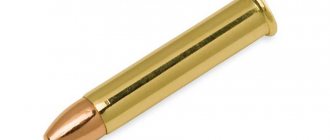The Elk carbine is one of the most famous and popular domestically produced rifled carbines among hunters. It has been produced at the Izhevsk Machine-Building Plant for more than 50 years.
The Elk carbine has earned a high reputation among hunters for its high technical characteristics, affordable price and good adaptability to our weather and climatic conditions.
The Elk carbine is designed for hunting medium and large animals and has a wide range of models from different years of production, each of which has its own advantages and disadvantages.
History of creation
The first model of the carbine was created on the basis of its famous predecessors, the legendary Mosin rifle of the 1891/1930 model and the lesser known “cavalry carbine” of the 1947 model.
Commercial hunters of the Soviet Union were in dire need of a high-quality and inexpensive rifle, suitable in its characteristics for commercial hunting.
The Mosin rifle available at that time had a good rate of fire for those times, but did not have sufficient cartridge power and, most importantly, was poorly suited for fishing due to its large weight and dimensions.
The Berdan rifle, thanks to its high power, made it possible to hunt with it even the largest animal, but at the same time it was single-shot and, like the Mosin rifle, had too large dimensions.
The designers of the Izhevsk Machine-Building Plant were tasked with developing a rifled repeating rifle for hunting medium and large animals.
Since 1961, the plant in Izhevsk has produced three carbines based on the three-line Mosin rifle: KO-8.2 chambered for 8.2x66, KO-8.2M carbine chambered for 8.2x66M, and KO-9 carbine chambered for 9x66. The bullet energy of all these carbines was not enough, so it was decided to develop a new version of the carbine.
In 1964, designer A.S. Shesterikov developed the KO-8.1-1 carbine, chambered for 8.2x66 cartridge; this carbine is also known as Los-8.2.
Since 1965, this carbine began to be produced under a more powerful 9x53 cartridge, and the carbine was renamed KO-9-1 (Los-9), or simply the “Los” carbine. The Los carbine in 9x53 caliber was mass-produced at the Izhevsk Machine-Building Plant from 1965 to 1976.
In 1975, designers A.S. Shesterikov and M.F. Luchinkin modernized the carbine chambered for 7.62x51. This carbine was called Los-4. It was produced at the Izhevsk Machine-Building Plant from 1977 to 1990.
In 1990, a new improved modification of the carbine was released, also chambered for 7.62x51, which was designated the Los-7 carbine.
Soon a modernized version of the Los-7-1 carbine was released. At the request of hunters, significant changes were made to the design of the Los-7-1 carbine.
In 1995, modifications of the Los-9 carbine appeared for new types of domestic and foreign cartridges: Los-9-1, Los-9-2 and Los-9-3.
Since 2016, the Los-10 carbine has been produced, which is the newest version of this carbine, which has been significantly modified to meet modern requirements, but at the same time has retained all the advantages of all carbines of the Los family.
Based on the Los carbine, the following were created: a sports rifle of 6.5 mm caliber BiL-6.5 and an army training rifle AVL of 7.62 mm caliber.
The Los carbine was used as a prototype in the development of shotguns and rifles of the Bars series. They differ in design and use more modern materials, but have many of the same characteristics.
Overview of modifications
Of course, since the creation of the Mosin rifle and the cavalry shortened model of small arms created on its basis, weapons progress has made a giant leap forward. Today, the “Los” carbine bears little resemblance to its predecessors of the past, and even more so to the century before last. Modern models of this family consist of the following modifications.
Los-7
The “Los-7” hunting carbine, developed for a 7.62x51 mm (A) caliber cartridge, compatible with ammunition of the corresponding caliber of NATO countries, replaced the model with the “4” index, which was discontinued in 1991. In addition, the 7th version has a version developed for the 5.6x39 cartridge, while the Los-4 carbine did not have a modification for a lightweight cartridge.
The peculiarity of the “seven” lies, in particular, in the fact that the rifle magazine is an integral structure. Structurally, the Los 7 carbine largely repeats the features of its predecessor.
Los-7.1
The main difference that the Elk 7.1 hunting carbine has is its removable magazine. As for the design, characteristics, dimensions and weight, this modification is similar to the “pure seven”.
Series 9 family
The newest generation of hunting weapons of this family, which includes three modifications.
The product line that makes up the Los-9 carbine brand consists of the following samples:
- carbine Los 9.1, using a 9.3x64 mm cartridge;
- modification 9.2, developed for the classic NATO “civilian” ammunition 7.62mm Brenneke;
- hunting carbine "Los-9.3", caliber 7.0x65 mm.
Thus, the “Los” brand carbine hunting weapon is a serious competitor to rifles and carbines from Western manufacturers, which are quite expensive, often capricious and not always adapted to Russian climatic conditions. It should be noted that the hunting weapons of this series, among other things, served as a prototype and a kind of “relative” of shotguns and rifles of the “Bars” family, which have similar characteristics, but differ in some design features and the use of more modern materials.
Design
By its design, the Elk carbine is a typical bolt-action carbine.
The barrel of the Elk carbine is rigidly attached to the receiver using threads. The barrel length is 550 mm, the barrel has 6 right-hand rifling with a length of 320 mm. In the breech of the barrel there is a thickening in which the chamber is located.
The chamber and bore are chrome plated.
The barrel is made of high quality steel, the barrel length is optimal for weapons of this type.
The carbine bolt is of a longitudinally sliding type, with rotation when locked. The bolt is locked using two lugs, which are located in the front of the bolt. Inside the bolt there is a firing pin and a mainspring. The bolt of the Elk carbine is distinguished by its simple and reliable design, but the disadvantage of such a bolt is its large longitudinal stroke, which increases the overall length and weight of the carbine.
The trigger mechanism of the carbine is located in a separate trigger box, the trigger of the carbine is adjustable. The control mechanism allows you to set the release to either operate with a warning or operate with a smooth release. Regulation is carried out by two screws screwed into the trigger box.
The Elk carbine has a safety, which, when set to safety mode, blocks the opening of the bolt and locks the trigger.
carbine moose
The Elk carbine magazine is box-shaped, stamped. The magazine is attached to the bottom of the receiver. The basic version of the carbine has a magazine that holds five rounds; when tuning the Los carbine, the standard magazine is often replaced with a more spacious one. Detachable box magazines are very reliable and easy to use, so they are often used in the design of various carbines and rifles.
The Los carbine is equipped with open-type sighting devices: a front sight and an aiming block. If the owner wishes, the carbine can be equipped with an optical sight; for its installation on the receiver there is a base for attaching the sight bracket.
The stock of the Elk carbine is most often made of birch, much less often of walnut. The butt has a semi-pistol neck and is not adjustable in length. The butt neck is reinforced with a Nagel bolt. The stock has front and rear swivels for attaching a rifle sling. The wood processing is of quite high quality; when using the carabiner, it retains its attractive appearance for a long time.
Operating principle
The principle of operation of the mechanism of the Elk carbine is similar to the principle of operation of any carbine with a bolt action:
- To load the carbine, place cartridges in the detachable magazine
- Turn the bolt by the bolt handle counterclockwise and pull it back, in this case the cartridge from the magazine will be on the cartridge feeder lever, the mainspring will be cocked
- When the bolt moves forward, the cartridge is fed into the chamber, the bolt is locked when the bolt is turned clockwise by the handle
- When you press the trigger, the firing pin, under the action of the mainspring, strikes the cartridge primer, causing a shot to occur.
- During the next charging cycle, a new cartridge is fed from the magazine, while the spent cartridge case is thrown out through the reload window
Advantages and disadvantages of the Elk carbine
The Elk carbine has significant advantages, thanks to which it is popular among hunters:
- Very simple and reliable design of a longitudinally sliding shutter, which does not require much effort during maintenance
- High sighting range, up to 300 meters
- Good accuracy of the carbine
- High stopping power, allowing you to hunt medium and large sized animals
- The ability of the carbine to operate at temperatures from -25 to +50°C; not all imported carabiners can boast of reliable operation in such temperature conditions
- Low weight of the carbine
- Small overall dimensions
Owners of the Los carbine also note some disadvantages inherent in this carbine:
- Some carbines have poor-quality processing of the bore and insufficient quality of chrome plating of the bore and chamber
- Slow shutter movement, lack of smooth movement and even jamming.
- Poor design of the removable magazine; for some carbines, the magazine can fall out and get lost during hunting, and sometimes cartridges get stuck in the magazine
- Many hunters complain about the inconvenient fuse
- The Elk carbine, like other bolt-action carbines, has a fairly low rate of fire, especially compared to self-loading carbines, which can be inconvenient for some types of hunting, such as driven boar hunting or elk hunting.
In conclusion, it should be noted that the advantages of the Elk carbine in the eyes of most hunters significantly exceed its disadvantages, which is why it has become so popular among both amateur and professional hunters.
The new Elk carbine surprised with its quality and price
Photo by the author.
I have already held the new carbine in my hands at exhibitions, but I was wondering what it would become like when (and if) it survives its introduction into the series.
It survived the implementation and remained almost unchanged.
Why almost?
In fact, unlike the pre-production samples, only the shape of the stock has changed, and quite a bit.
The concern listened to the criticism, and instead of an incomprehensible bevel, an unremarkable, but convenient end of the forend of the usual “slicked” shape appeared in front.
This is absolutely logical and correct: the form previously proposed by designers and embodied in the first samples was certainly beautiful, but completely non-utilitarian.
The stock constantly caught on branches and items of equipment.
Of course, the profile of the carbine has lost some design flair, but the new “Los” is a utilitarian carbine, and such a change is completely justified.
The weapon leaves an ambivalent impression. All elements are made at a high level, harmonious and beautiful. The stock is conveniently shaped, suitable for both right-handed and left-handed people.
People of different builds note that this carbine is flexible, when thrown, it fits in place, and the front sight fits into the rear sight slot like a glove.
I would especially like to mention the butt plate. It is combined: the upper part is plastic, the lower part is rubber.
Read the material “Baikal 145 Los - a new and reliable carbine with strong roots”
At first this is perceived as a design element, but after using it several times, you suddenly realize that an experienced hunter could not help but take part in the development of such a butt plate.
The plastic upper part is made so that when the butt plate is thrown up, it does not cling to clothing. And it works. Remember how inconvenient it can be, especially if the butt plate is made of soft rubber, to raise a gun or rifle.
The butt plate does not slide over the clothes, but tends to lift them up, and “dancing with a tambourine” begins: how can one practice the throw so that the weapon passes over the clothes and then sticks straight into the shoulder?
With the new butt plate you don’t think about it, it doesn’t catch or lift anything. How the rubber part works will become clear when shooting, but I think everything will be fine with this too.
| At the end of the barrel there is a 15x1 thread, closed with a protective sleeve. Photo by the author. |
The semi-pistol grip is also comfortable and beautiful; the magazine hardly protrudes from the stock and fits harmoniously into the overall design of the weapon, since it is four-round (apparently, they tried to adjust its size to create an overall harmonious profile).
The handguard noticeably tapers towards the front of the carbine, which is completely justified from an ergonomic point of view. The handguard is comfortable, easy to hold, and you can choose a place exactly according to your hand, a little forward - a smaller girth size, a little back - a larger one. It’s comfortable and your hand doesn’t slip.
The Picatinny rail stands out a bit from the overall design. It is certainly useful, but it completely destroys the upper profile of the carbine.
Now about the sad stuff. Despite the fact that all the elements are individually stylish and, one might say, beautiful, the general perception of the rifle is ambiguous. Remember "ten"?
The design, new and fresh at the time, was spoiled by a “heavy butt,” which is why the car was almost immediately nicknamed the “pregnant antelope.” Something similar happened with the new “Moose”: the butt is “outlined” well, but the general impression is that the rear part outweighs it, and very much so.
That is why, when you pick up a new rifle, you experience cognitive dissonance, you prepare for the fact that the weight distribution will be hopelessly ruined, but it is actually very good.
Read the material “Los Carbine: The First Soviet Hunting Carbine”
It’s curious, but I couldn’t help but think that the design of the stock was made for the plastic version: that’s where utilitarianism is most in demand and this shape will look harmonious.
But the stock is made of walnut, a noble tree, and, apparently, this causes protest. So, I think future owners will have to get used to the unusual, but technically justified design.
In general, I don’t understand why everything we do for the civilian market turns out to be a little crude, despite the fact that military design is, as a rule, excellent.
| PHOTO SHUTTERSTOCK |
But let's return to the design of the carbine. The new carbine comes with bedding by default, which is interesting and truly fresh. Bedding is a method of laying “iron” in a stock, in which the box has maximum contact with the stock, and the barrel is completely hanging out.
This is achieved by using special epoxy or other resins.
As the name implies, a special “bed” is formed for the box in the stock, each time specifically for a different barrel-box set, which makes it possible to install the box in the stock as accurately as possible, and this immediately and positively affects the accuracy of fire.
And now all new “Moose” in both calibers will come with bedding.
Why is the new “Moose” a new carbine, and not a continuation of the good old “Moose” line? But because this is a completely different carbine, and the reason for this is the new bolt on three lugs.
Actually, it could have been called by a different name, since after the transition to a new shutter there was nothing left of the old “Moose” except the name. Three stops is definitely a step forward.
Read the material “Improving the accuracy of the domestic rifled carbine”
This includes opening when turning 60°, increasing the reloading speed, and the ability to fire without lifting the butt from the shoulder, but this is not quite the “Moose” anymore. By the way, the shutter has undergone other changes.
For example, a spring-loaded reflector for cartridges appeared. As we remember, in old carbines the reflector bumped into the sear and transferred this impulse to the sleeve. For good extraction it was necessary to push the shutter back quite sharply.
In the new carbine, extraction no longer depends on how fast you move the bolt; the cartridge case will rest against the inside of the box and, as soon as it reaches the window, will be thrown out. This method is considered more progressive and convenient for the shooter.
| The magazine is detachable, single-row, with three rounds. Photo by the author. |
In addition, the shutter now has a two-position fuse (let me remind you that previously the fuse was on the box). In the forward position, a red dot appears and you can shoot; in the rear position, shooting is impossible and the shutter is locked - it cannot be opened.
In general, we received a completely new bolt, and with it a carbine. Undoubtedly, the new mechanism is more progressive, but time will tell whether it will be better and more in demand than the old one.
On the new carbine, a 60° rotation is rated as an absolute plus, but the stops themselves clearly require additional polishing. The shutter does not open as softly and smoothly as we would like.
The good news is that there is a thread at the end of the barrel. On the carbine it is covered with a protective sleeve, but it can be twisted, and under it there will be a wonderful long 15x1 thread (the right one is for installing muzzle devices).
You can install flame arresters and other useful devices. It's nice that certifiers finally realized that barrel threads have many benefits and can be allowed.
Of course, it spoils the design of a classic hunting rifle a little, and I really can't wait for someone to ask:
“Is it possible to order a carbine without a thread at the end of the barrel?” But there are no such things yet, which means that designers with threads at the end of the barrel hit the mark.
Read the material “Suppressor for rifled and smooth-bore weapons: what you need to know”
The magazine is plastic, single-row, .308 caliber, three rounds. Its very unusual but convenient release is located in front of it, and when the magazine is inserted into the carbine, the release fits inside the magazine. The carbine kit includes two magazines.
| Open sights are small and do not interfere with the installation of optics. Photo by the author. |
Installing optics should not be difficult. The Picatinny rail is the standard and most convenient option for a hunting rifle. A huge number of brackets are sold for it, as they say, for every taste and budget.
The optics can be placed as low as the shutter handle will allow. There are also conventional, open sights that are as discreet as possible and do not interfere with optics.
The front sight is small, without a muzzle, and is adjustable in the vertical direction. The rear sight can move horizontally for zeroing, but does not move vertically and is zeroed at one distance.
The carbine barrel is forged, with four rifling, with a pitch of 255 mm. Interestingly, the passport provides for a 320 mm option, but what is meant is not entirely clear. The barrel and chamber are chrome-plated, which is emphasized in all information materials.
By the way, this puzzled me a little. Well, does it really happen that the barrel is chrome-plated, but the chamber is not? I have only seen this once - at Molot Arms, when they take ready-made chrome-plated barrel blanks and unroll the chambers themselves.
Now a few words about the new line of “Los” carbines. Apparently, we have lost the Bars series carbines. In fact, it was the same “Moose”, but on a smaller box for cartridges, with a short sleeve. Now all carbines will be called “Moose”. A carbine chambered for the .223 cartridge was launched with the short frame, and a carbine chambered for the .308 cartridge with the long frame. Actually, that's all for today.
Read the material “Lamination of state hunting tickets and weapons permits: legal or not?”
Why the Kalashnikov Concern decided to combine the lines is unclear, but this is a fact that we will have to get used to.
If earlier, when saying “Bars”, everyone understood what was being said, now it will be necessary to clarify the caliber in order to understand what is meant. There is logic in both the first and second divisions, since it is not clear what is more important: the length of the box or the design of the carbine.
| Photo by the author. |
Today you can choose from two calibers - .308 and .223. Why? Hard to say. Most likely, due to the versatility of each in its segment, due to the fact that both calibers are produced in Russia and are available for reasonable money. And at the same time, for critical shots you can always purchase imported cartridges, which is important.
In my opinion, the carbine turned out to be good. Design flaws are a matter of taste, the main thing is that there are no complaints about quality.
Yes, I want more calibers. Yes, a plastic stock suggests itself. But I think it's all a matter of time. If our hunter accepts a new carbine, we will have both variety and design options.
Alexander Kudryashov January 24, 2022 at 05:56
Purpose
The main purpose of the Elk series carbines is hunting medium and large-sized animals; they can be used by both professional hunters and amateurs.
Due to their design and simplicity of design, in addition to hunting, carbines of the Elk series can be used for training and teaching shooting; due to their ergonomics and relatively light weight, they are well suited for both men and women and teenagers.
Specifications
The technical characteristics given below in table form will allow you to get a more complete picture of the capabilities of the carbine, which is due to the parameters invested by the manufacturer during the manufacturing process of the carbine.
| Specifications | Carbine Los 7 1 |
| Manufacturer country | Russia, machine-building plant Izhevsk |
| Purpose | Hunting, sport shooting, entertainment, accuracy training |
| View | Self-loading automatic carbine |
| Ammo capacity | From 5 to 9 |
| Overall body length | 1 120 mm |
| Barrel length | 625 mm |
| Model height | 202 mm |
| Weight | 4.89 kg |
| Width | 57 mm |
| Type of trunk | Cold forged, oxide coated |
Thanks to its simple design, the Los 7 1 carbine can be successfully used in training beginners, while the ergonomics of the stock allows both men and women to train in accuracy with maximum convenience, regardless of their build and hand size. And excellent shooting performance (the aim of shots, their accuracy and the range of the bullet due to its high initial speed) are guaranteed by the manufacturers and allow you to get maximum pleasure from the process of shooting from the carbine in question.
Los-4
The Los-4 carbine was produced by the Izhevsk Machine-Building Plant from 1977 to 1991. The carbine was chambered for 308Win (7.62x51).
The number of rifling in the bore of the Los-4 carbine was changed; instead of 4, 6 riflings were made, this had a positive effect on the accuracy of the carbine.
The carbine bolt handle was replaced and became more conveniently shaped.
The design of the trigger box and cartridge case reflector were changed.
A new part of the trigger mechanism was introduced into the design of the Los-4 carbine: a disconnector. The use of a disconnector made it possible to increase the reliability and service life of the trigger mechanism.
The carbine's magazine is detachable and holds 5 rounds.
The butt of the carbine was lengthened by 20 mm, and the shape of the forend was also changed. All the changes that were made to the design of the Los-4 carbine improved its ballistic qualities, reliability, and ease of use, which were appreciated by our hunters.
Los-7
The Los-7 carbine replaced the Los-4 carbine. It has been produced at the plant in Izhevsk since 1991. The purpose of creating this modification was to unify the parts of the Los and Bars carbines so that they could be produced on the same production line without readjusting equipment.
The design of the Los-7 carbine was based on the time-tested design of the Los-4 carbine. From him the carbine received a barrel, receiver, locking system, magazine, and stock. The Bars-4 and Los-7 carbines have 85% of common parts.
The stock of the Los-7 carbine was most often made of birch and only custom-made carbines were made of walnut. The butt of the carbine has a pistol neck and comb. A rubber shock absorber was installed on the back of the butt to reduce recoil.
The Los-7 carbine is designed for use under the 7.62x51 (308Win) cartridge; foreign-made cartridges can also be used. The magazine of the Los-7 carbine is of an integral design, designed for 5 rounds.
Baikal 145 Los - a new and reliable carbine with strong roots
For hunting relatively small and medium game, the high-velocity 5.6x39 cartridge designed by Blum was chosen, while for hunting large game the choice was made on the 9x53R cartridge.
The projects were named "Leopard" and "Moose" respectively and were carried out independently of each other by different groups of designers, which determined significant differences in design between these two carbines.
The first "Bars" had a compact bolt group due to the use of locking with two lugs behind the magazine window when turning the bolt.
The box-shaped integral magazine could be loaded with one cartridge at a time through a window in the receiver and unloaded by folding the bottom of the magazine.
The Los carbine had a much more massive receiver; its rotary bolt was locked with two stops in the front.
On the upper surface of the receiver there were dovetail-type seats for installing an optical sight bracket.
The design of the magazine cover that folds down was solved in an original way - it was made in one piece along with the trigger guard.
Experience in the production and operation of these carbines soon led to the appearance of new modifications - the Bars-4 and Los-4 carbines.
Read the material “Los Carbine: The First Soviet Hunting Carbine”
The new “Moose” was not very different from its predecessor; its main innovation was the use of the 7.62x51 cartridge. At the same time, Bars-4 was radically redesigned and received a new bolt group and receiver.
Later, variants of the Los-7-1 and Bars-4-1 carbines appeared, which received detachable magazines.
However, time passed, and the time had come again to modernize the carbines that had already been time-tested and had become popular among domestic hunters. Instead of “cosmetic” improvements, it was decided to create virtually new models on the platform, which initially became known as “Los-10”.
These new carbines differ from their predecessors primarily in the modified design of the receiver and locking unit.
The bolt received three lugs instead of two, which made it possible to reduce the angle of rotation of the bolt handle from 90 degrees to 60, making reloading faster and more convenient.
An integrated Picatinny rail has appeared on top of the receiver for quick and convenient installation of any type of modern optical sights; there are also mechanical open sighting devices - a front sight and a horizontally adjustable rear sight.
The receiver is placed into a classic wooden stock using special resin and bushings (“bedding”).
The single-row magazine made of impact-resistant polymer has also become new, having an original fixation system and ensuring a stable and reliable supply of cartridges into the barrel.
The barrel itself is made using radial compression technology (also known as cold rotary forging) and has a chrome-plated bore and chamber, which provides a long service life, including when firing “budget” cartridges with a bullet in a bimetallic jacket, and also simplifies cleaning after shooting.
The muzzle of the barrel has a standard M15x1 thread (right), which is used for installing various muzzle devices that will be sold separately.
Removing and putting the weapon on safety, thanks to the convenient location of the latter on the shank of the bolt, is carried out naturally and familiar to the hunter with the movement of the thumb of the right hand.
Read the material “Improving the accuracy of the domestic rifled carbine”
The bases of the Uncle Mike's type swivels allow them to be used not only for attaching a belt, but also for installing bipods and other attachments.
The wooden stock is equipped with a combined butt plate, which effectively absorbs recoil.
This carbine was launched into production at the Izhevsk Mechanical Plant, part of the Kalashnikov concern, under the brand name Baikal 145 Los, chambered for the popular .308 Winchester cartridge, which is available in a wide range of options.
Small change hunters were also not left out. For them, a version of the Baikal 145 Elk carbine with a shortened frame was launched into production, which retains all the advantages of the new model described above, but has a slightly lighter weight and uses .223 Remington cartridges, also available in the widest range of equipment and prices.
Brief characteristics of the Baikal 145 Los carabiners:
November 16, 2022 at 10:54 am
Los-7-1
The Los-7-1 carbine has been produced since 1995. In its design and characteristics, the Los-7-1 carbine is similar to the classic Los-7 carbine, with the exception of 3 changes:
- The fuse of the carbine of the previous model caused a lot of complaints from hunters; the fuse turned out to be too small and it was inconvenient to use, especially in winter, so in the Los-7-1 carbine it was replaced with an old-style flag-type fuse.
- The Los-7-1 carbine's magazine was replaced: instead of a fixed 5-round magazine, a detachable four-round magazine was installed. When hunting, you can quickly reload the carbine by installing a new loaded magazine and continue shooting.
- According to the wishes of the hunters, the front sight on the Los-7-1 carbine was replaced from a front sight in a ring-shaped muzzle to an open knife-shaped front sight.
Just like the previous model, the Los-7-1 carbine was chambered for 308Win (7.62x51).
Review of the rifle Los 7-1
The advantage of the Los 7 1 model is its adaptability to the conditions of our country, since imported analogues cannot always cope with sudden changes in temperature and humidity, maintaining their excellent qualities and having a high shooting level. Thanks to the good processing of natural materials that were used in the design of the butt of the model in question, the Los 7 1 carbine retains its attractive appearance for a long time, even mechanical impacts, which are inevitable when using it in the field, do not have a significant impact on its condition.
External data of the model also had an impact on the degree of demand for the carbine. Due to its compact size and relatively low weight, the carbine is often used for training in shooting skills, and it is quite easy to transport. With its advantages, the Los 7 1 model stands out among other similar carbines that can have the same widespread use.
Disassembling the bolt of the Los 7-1 carbine is shown in the video below:
Advantages and disadvantages
Possessing a significant number of positive characteristics, the Los 7 1 model has become in demand among both professionals and novice shooters: its relatively low weight and compact size ensures both ease of movement of the carbine and the possibility of its most convenient use when shooting - and for men of any size, and for women.
By analyzing the existing positive characteristics and shortcomings of the manufacturer, you can get the most complete picture of this carbine, and reviews from its owners will provide an understanding of the strengths and weaknesses of the Los 7 1 model.
The most fundamental advantages of the model under consideration include:
- ergonomics of each design detail and thoughtfulness of the parameters of the entire carbine;
- modern design using both natural materials (walnut and birch wood) and modern polymer materials with high resistance to external influences (temperature changes, high humidity, frequent mechanical stress);
- the thoughtfulness of the shape of the carbine, which allows you to place it on your shoulder with the greatest convenience and not feel significant recoil when firing;
- the presence of an optical sight with good characteristics in the basic configuration, which allows shooting with high levels of accuracy and aiming;
- The stylish external design immediately attracts the attention of buyers, while the absence of unnecessary details makes it possible to classify this carbine as a classic model of firearms.
Having all the many positive qualities and an affordable price, the Los 7 1 carbine can be considered one of the most frequently purchased models. Modern and attractive due to its external design, the carbine of the Los 7 1 model has proven itself in hunting, in the field and when used for accuracy training. The firing range and accuracy are determined by the established technical parameters.
According to the owners of the model, the carbine has no shortcomings.
Carbine Los 7-1 (photo)
Purpose
The Elk 7 1 carbine can be used both for professional hunting of animals and for accuracy training. Thanks to its successful design and simplicity of the device, it can also be used for teaching shooting skills: it is relatively lightweight and compact, it can be easily used by both men and women, as well as teenagers. Due to these characteristics, the carbine is easy to transport.
Varieties
Today, the Los 7 1 carbine is offered for sale with 7.62x51A caliber cartridges, which can be used for hunting large and medium-sized animals, as well as with .308Win caliber cartridges. Both versions of the carbine have proven themselves to be excellent for hunting, as well as for accuracy training.
Technical characteristics of the Los 7-1 carbine are given below.
Los-9
The Los-9 carbine was produced from 1965 to 1977, and is the most popular and well-known version of this carbine.
In 1977, it was replaced in production by a newer, improved version of Los-4.
In 1995, a new generation of the Los-9 carbine was released, including three modifications: Los-9-1, Los-9-2 and Los-9-3.
- The Los-9-1 carbine uses a 9.3x64 mm cartridge. The 9.3x64 mm cartridge is a very powerful ammunition designed for hunting medium and large game. When fired, a bullet of this caliber has a very high muzzle energy, comparable to the energy of the 375 H&H Magnum cartridge. Initially, a cartridge of this caliber was developed in Germany in the 20s of the 20th century; its own version of this cartridge was developed in the Soviet Union by Blum in the 80s of the last century.
- The Los-9-2 carbine uses the 7.62x63mm cartridge, also known as the .30-06 Springfield. The .30-06 Springfield cartridge was originally developed for military use and is still used by the US Army as the primary rifle cartridge. The 30-06 Springfield cartridge is very well suited for hunting large elk and wild boar at medium range.
- The Los-9-3 carbine uses a 7x65 mm cartridge; this type of cartridge was originally developed for hunting use and is the most powerful 7mm caliber cartridge.
The Los-9 carbine is a serious competitor to much more expensive rifles and carbines from foreign manufacturers, which are not always adapted to our climatic conditions.
Baikal 145 Elk: new for the hunter
Photo: kalashnikov.media
The Kalashnikov Concern has opened pre-orders for the Baikal 145 Los hunting carbine from June 13, 2022. We can say that it was the “Los” that became the first Soviet civilian hunting carbine. Over 50 years of use, it has earned a reputation as a simple, reliable and accurate hunting weapon. At the beginning of this decade, work began on modernizing the rifle in Izhevsk. Baikal 145 Elk is a completely new generation of this product.
The carbine first went into production in the thirties of the last century. It was a hunting version of the three-line “mosinka”, which used 7.62x54 caliber cartridges. In 1965, this carbine was significantly modernized by Izhevsk designers. The main change was the redesign for the Blum cartridge, which was intended for hunting large game (bear, elk). For this reason, the carbine got its name “Moose”. In a fairly short time, “Los” became popular for a number of reasons: quite affordable cost, simplicity and reliability in operation, lightness. Despite the successful design solution and efficiency, proven over the years, the line of hunting weapons requires regular restyling of old ones and the release of new models.
Now both Izhevsk arms factories are part of the Kalashnikov Concern, and all hunting weapons in Izhevsk are produced under the Baikal brand. One of the Concern’s new products is the Baikal 145 Los carbine. The rifle with manual reloading has a classic appearance and at the same time fully meets modern requirements in terms of ergonomics and reliability.
The rifle stock is made of walnut wood. Baikal 145 Elk is equipped with a butt pad, which consists of a shock-absorbing part and a plastic heel. This allows the carabiner not to cling to clothing during a quick release and effectively dampen recoil.
The bolt with three lugs ensures locking strength and fast reloading with an opening angle of 60 degrees. The barrel is freely hung, the receiver is installed in the stock using a special resin using bedding technology, which ensures high accuracy of fire.
The bore and chamber are chrome-plated to increase corrosion resistance and the possibility of using ammunition with a bimetallic bullet jacket. The weapon has a muzzle thread for mounting various sighting devices and a Picatinny rail for mounting optics. The fuse is located on the bolt shank. Turning the safety on and off is done with the thumb of the right hand.
The Baikal 145 Los hunting rifle is offered in two versions: with a short (chambered .223 Rem) or standard (chambered .308 Win) receiver and bolt. The carbine barrel length in both calibers is 550 mm. Weight with an empty magazine, without an optical sight and accessories, for a 5.56 mm carbine is 3.3 kg, for a 7.62 mm carbine - 3.4 kg.
The Kalashnikov concern has already opened pre-orders for a new hunting rifle. The first shipment to customers in Siberia and the Far East is expected before the end of June 2022. In regions closed to arms trafficking during the World Cup, retail sales of products will begin in August 2022.
Los-10
The Los-10 carbine is the newest version of the carbine, produced by the plant since 2016. The carbine has retained all the advantages of previous versions of the Los carbine and, thanks to serious modifications, has acquired new advantages.
- The barrel of the Los-10 carbine is made by cold forging with an oxide coating
- The rifling pitch of the Los-10 carbine allows the use of heavier bullets.
- The muzzle of the carbine has a thread that allows the installation of flash suppressors, brake compensators and other muzzle devices.
- The shape of the butt is symmetrical, which allows both right-handed and left-handed people to shoot from the carbine.
- The stock is made of walnut, birch or maple.
- The receiver has a Picatinny rail for mounting an optical sight.
- The open sight has been upgraded to provide higher aiming accuracy.
- The magazine is of a new design, does not rattle or fall off
- The new bolt design has easier cocking and a shorter stroke.
- The bolt is locked with three lugs.
- The Los-10 carbine has a modern Cerakote protective coating.
Disassembly
Disassembly may be required to repair the rifle, perform tuning, or perform routine maintenance on the rifle. No special tools are required to disassemble the carbine.
To disassemble the carabiner, follow these steps:
- Unload the rifle and make sure there is no cartridge in the barrel chamber.
- If an optical sight is installed on the carbine, unscrew the nuts of the sight bracket and remove it.
- Open the bolt, pull it back by pressing the trigger, and remove the bolt from the receiver.
- Remove the magazine cover, unscrew the connecting screws, and remove the barrel and receiver.
- Remove the bar with the magazine feed, knock out the axle and trigger pin, and remove the trigger box.
- Remove the fuse by moving the fuse box to a horizontal position.
- Disassemble the bolt; to do this, move the clutch forward and turn it clockwise, remove it from the bolt, and remove the mainspring with the firing pin.
The carbine is assembled in the reverse order.
Tuning
Owners of the Los carbine can, if desired, tune it; most often it is upgraded as follows:
- The optical sight is replaced with a more modern and higher quality one, with more powerful magnification.
- They change the stock to a more advanced one, made of higher quality wood, or even install a plastic stock.
- The carbine magazine is replaced with a more spacious one, which can be useful for certain types of hunting.
Product prices
Most models of the Elk carbine have long been discontinued and you can buy them either through advertisements for sale on weapons websites, or in the department of a hunting store, where used guns are presented.
Prices for Elk carbines of discontinued models depend on the condition of such a carbine and on the requests of its previous owner and most often range from 25 thousand rubles. up to 40 thousand rubles.
Of the Los carbines, only two models are currently produced, these are Los-7-1 and Los-10. Their prices in stores most often range from 30 to 45 thousand rubles.
Options and packaging
The basic kit for the Los 7 1 carbine includes an optical sight, which can be replaced with a more voluminous one, a front sight, a forend and a cleaning rod for cleaning the weapon. Also, when sold, the carbine is accompanied by a quality certificate and an individual passport.
The carbine is packaged in a polymer material: this makes it possible to maintain its attractive appearance during transportation and avoid damage to the relatively soft wood that forms the butt.
Los-7-1 (308 Win) Legion
Owner reviews
Over the many years that Los carbines have been produced, a large number of reviews from owners about these carbines have accumulated. The vast majority of these reviews are positive.
Owners of the carbine note the good appearance of the carbine, its good technical characteristics, and high firing range.
The Elk carbine is a fairly inexpensive hunting carbine, reliable, accurate, long-range, well suited for hunting medium and large animals in our hunting conditions.


